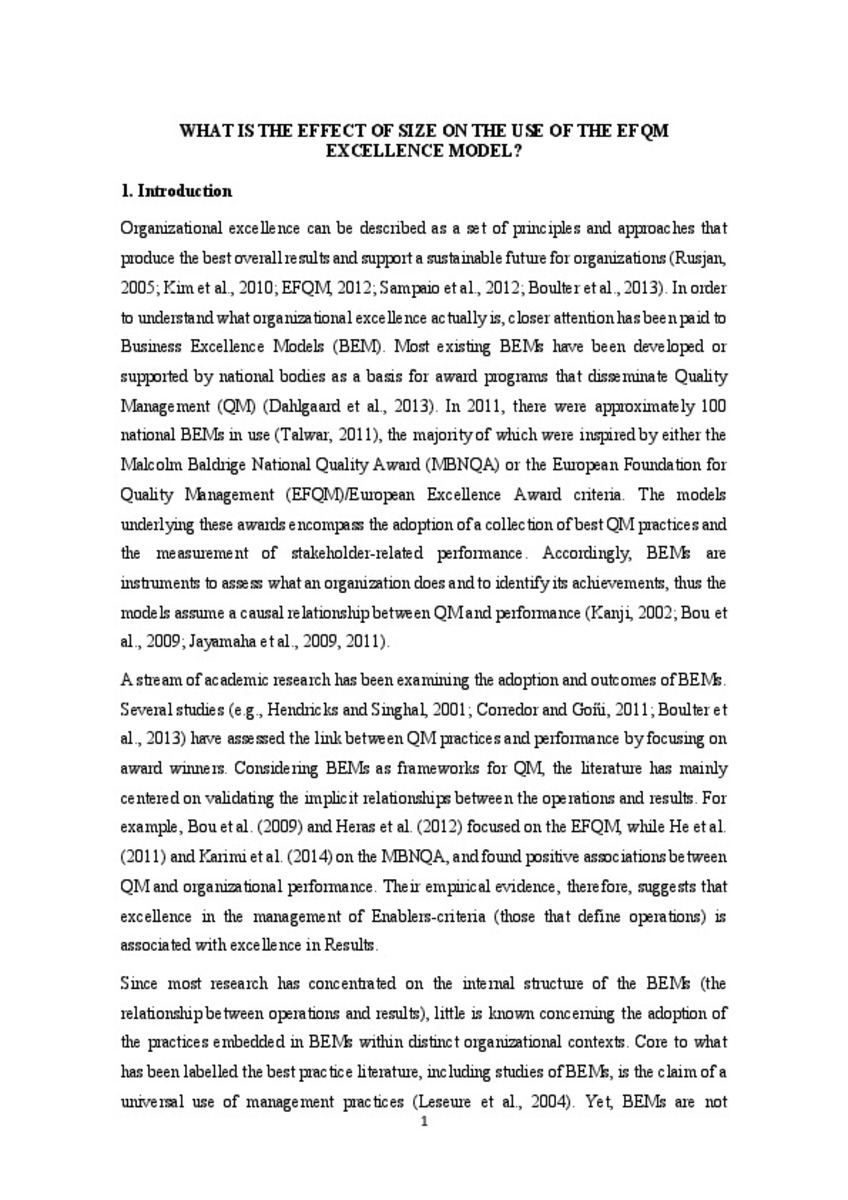Mostrar el registro sencillo del ítem
What is the effect of size on the use of the EFQM excellence model?
| dc.contributor.author | Escrig-Tena, Ana B. | |
| dc.contributor.author | M. De Menezes, Lilian | |
| dc.date.accessioned | 2017-02-16T13:23:25Z | |
| dc.date.available | 2017-02-16T13:23:25Z | |
| dc.date.issued | 2016 | |
| dc.identifier.citation | Ana B. Escrig, Lilian M. de Menezes, (2016) "What is the effect of size on the use of the EFQM excellence model?", International Journal of Operations & Production Management, Vol. 36 Iss: 12, pp.1800 - 1820 | ca_CA |
| dc.identifier.issn | 0144-3577 | |
| dc.identifier.uri | http://hdl.handle.net/10234/166100 | |
| dc.description.abstract | Purpose – By contrasting a contingency with a universal approach to business excellence models (BEMs), the purpose of this paper is to investigate the effect of size on the use of the European Foundation for Quality Management (EFQM) model by organizations that were officially “Recognized for Excellence” in Spain. It considers the potential differences between large organizations and SMEs on the level of adoption of EFQM criteria and on the impact that enablers-criteria may have on key performance measures. Design/methodology/approach – This study uses actual sub-criteria and criteria scores attained by organizations in their assessment for EFQM recognition. Scores of a population of 216 organizations are analyzed via analysis of variance, factor and structural equations models. Findings – Although there are some criteria in the EFQM model that appear to be universally adopted irrespective of size, the empirical analyses indicate that size may shape the adoption of other criteria and the impact that enablers can have on results, thus supporting a contingency perspective. Moreover, the findings call for the revision of the relationships embedded in the EFQM model. Originality/value – In contrast to most previous research, which relied on surveys of managers’ perceptions, this study uses the actual scores achieved by organizations in their assessment for EFQM recognition. It addresses the effect of size on the whole model, which so far has been neglected in the literature. All in all this study contributes to the literature on contingency approaches to best practices, and more specifically to BEMs. To the practitioner, it provides guidelines for addressing perceived performance gaps in their pursuit of recognition for excellence. | ca_CA |
| dc.description.sponsorShip | The authors appreciate the financial support for this research from the Universitat Jaume I and Bancaixa Foundation (Ref. P1.1B2011-52), from the Generalitat Valenciana (Ref. AICO/2015/029) and from the Ministerio de Economía y Competitividad of Spain (Ref. ECO2011-25809, ECO2015- 66671-P) | ca_CA |
| dc.format.extent | 29 p. | ca_CA |
| dc.format.mimetype | application/pdf | ca_CA |
| dc.language.iso | eng | ca_CA |
| dc.publisher | Emerald | ca_CA |
| dc.relation.isPartOf | International Journal of Operations & Production Management Vol. 36 No. 12, 2016 pp. 1800-1820 | ca_CA |
| dc.rights | © Emerald Group Publishing Limited | ca_CA |
| dc.rights.uri | http://rightsstatements.org/vocab/InC/1.0/ | * |
| dc.subject | Business excellence | ca_CA |
| dc.subject | EFQM | ca_CA |
| dc.subject | Best practices | ca_CA |
| dc.subject | Contingency factors | ca_CA |
| dc.subject | Effect of organizational size | ca_CA |
| dc.title | What is the effect of size on the use of the EFQM excellence model? | ca_CA |
| dc.type | info:eu-repo/semantics/article | ca_CA |
| dc.identifier.doi | http://dx.doi.org/10.1108/IJOPM-11-2014-0557 | |
| dc.rights.accessRights | info:eu-repo/semantics/openAccess | ca_CA |
| dc.relation.publisherVersion | http://www.emeraldinsight.com/doi/full/10.1108/IJOPM-11-2014-0557 | ca_CA |
Ficheros en el ítem
Este ítem aparece en la(s) siguiente(s) colección(ones)
-
EMP_Articles [455]







